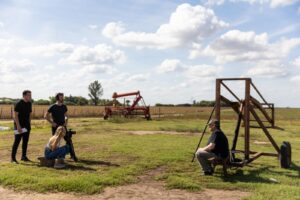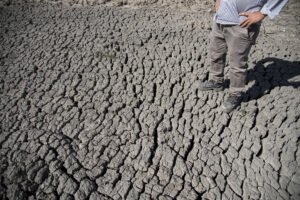Farmers who have worked the famous Argentine pampas for decades till dry, cracked soil that spits out a trail of dust in their wake. Ranchers watch as their emaciated cattle lie in parched fields.
These are scenes from a 22-minute documentary produced by Argentine newspaper La Nación that recently won the King of Spain International Award for Environmental Journalism.
“Pampa Seca” shows how the fertile grasslands that are home to gauchos, cattle, wheat, soy and corn, were hit with a three-year drought after lower than normal rainfall brought on by La Niña.
Through in-depth interviews with small and large rural producers, the journalistic piece delves into the consequences for an agricultural industry that experienced the greatest drought in the history of Argentina.

The production of “Pampa Seca” during field work. (Photo: Matías Boela/La Nación)
General producer, Matías Boela, and the journalist in charge of field work and interviews, Pilar Vázquez, told LatAm Journalism Review (LJR) what it was like behind the scenes of the documentary that, according to the jury of the King of Spain Award, is a “work on drought with a very close narrative to reflect a common problem in the world.”
Published in May 2023, a team of 10 journalists worked on “Pampa Seca.” In addition to Boela and Vázquez, they are: Matías Aimar, Julieta Bollini, Tomás Cuesta, Sol Coliva, Ezequiel Díaz, Andrea Platón, Belkis Martínez and Francisco Ferrari.
Boela said that “the strong point of ‘Pampa Seca’ is the life stories of the people.”
More than nine rural producers from the interior of Argentina told how a drought that lasted three years and caused a 50% drop in the country's agricultural production affected their work, their incomes and their personal and family lives.
“The countryside represents 17% of the Argentine GDP,” according to the report. “Agribusiness losses due to the drought represent a 3% drop in GDP.”
Vázquez explained that the La Nación journalistic team, prior to making the documentary, had already been documenting the strong impact of the drought on the Argentine countryside.
“We already knew the terrain and we were reaching the end of the drought, so that was like a summary of everything that happened in the countryside in those three years,” she said.
When choosing the rural producers to interview, the journalist said that the criterion was that they had to live in areas relevant to production for livestock and agriculture in order to show the impact of the drought in the most important sectors of the country, in this case: the south of Santa Fe, the north of Buenos Aires and the south of Córdoba.
Filming lasted three months, during which they made four trips to the countryside.
“We were there quite a bit to show the daily lives of rural producers ruined by the drought,” Vázquez said.
“The hardest thing to record was the story of a farmer who was clearing his field, taking the animals. He lost a lot, he had to pay for tanker trucks to bring water to the animals, he ate up his savings and could no longer support them. He told us that at night he would wake up to the ballad of the calves whose mothers were dying,” she said.
One of the iconic images of the documentary is that of a portrait of agricultural producer Gustavo Glailevra with several dead cows behind.

Argentine rural producer Gustavo Glailevra during the making of the documentary “Pampa Seca.” (Photo: Marcelo Manera/La Nación)
In addition to showing the stories of the producers, Boela said that “Pampa Seca” shows through plates, comparative photos, data and interviews with specialists the tons of corn, soybeans and wheat that were lost, as well as the amount of dollars that never entered the market due to the drought.
They interviewed two specialists: economist Ramiro Costa, director of economic studies at the Buenos Aires Grain Exchange, and Natalia Gattinoni, meteorologist at the National Institute of Agricultural Technology (INTA).
“The choice of specialists has to do with the institutions they support,” Vázquez explained. For example, “the Buenos Aires grain exchange evaluates weekly crop production in Argentina and Costa analyzes its economic impact.”
The importance of life stories in journalistic coverage
In retrospect, Boela said that this project taught him that no matter how big or small the problem may be, it must be related to a life story or a character so that it reaches the reader or consumer of that story.
“Otherwise it is very alien, you have to associate it with a face, bring it down to earth,” the producer said.
“I followed each of the stories and the documentary conveys everything that happened. We talk every day with rural producers, we show their day-to-day work, when they take out the tractor and go out to the field,” Vázquez said. “Behind those numbers and that economic impact, are these people who leave everything in a job that is everything to them.”
The challenge that “Pampa Seca” production faced, according to the journalist, was telling those who live in the city about the impact of the drought on the countryside and on the lives of rural producers.
“From the city, the countryside seems distant, we needed to create a closeness,” she added.

The drought in the north of Santa Fe during the production of “Pampa Seca.” (Photo: Cecilia Miljiker/La Nación).
“Let yourself be surprised”
The interviewees made some recommendations when covering a topic as large in scale as the drought that Argentina suffered for three years. Vázquez said that production prior to the interviews is very important.
“A lot of prior work was done to study who we were going to interview, contact them, organize trips to the countryside, but you also have to let yourself be surprised. Many times we would do an interview with a producer and ask for another contact, and we would end up in another field that we had not planned to go to where a spectacular story emerged.”
For Boela, the stories they told in the documentary require listening and time.
“It will take you more than two hours of coverage, for someone to open their heart you have to give them time and patience to understand what they are doing,” he added.
The producer also mentioned the importance of collaborative work in an audiovisual production.
“The cameraman must know what the story is about in order to show it,” he said.